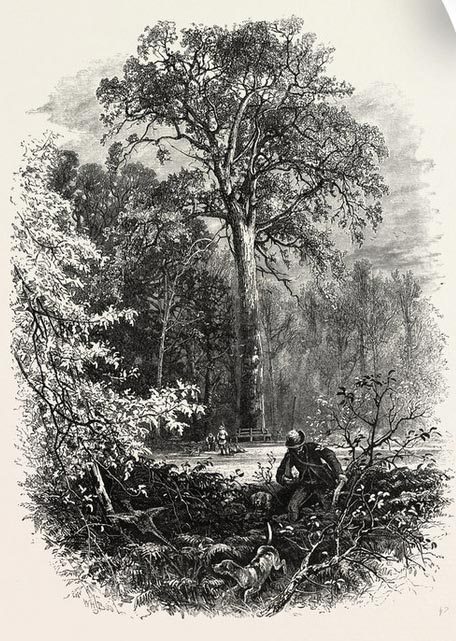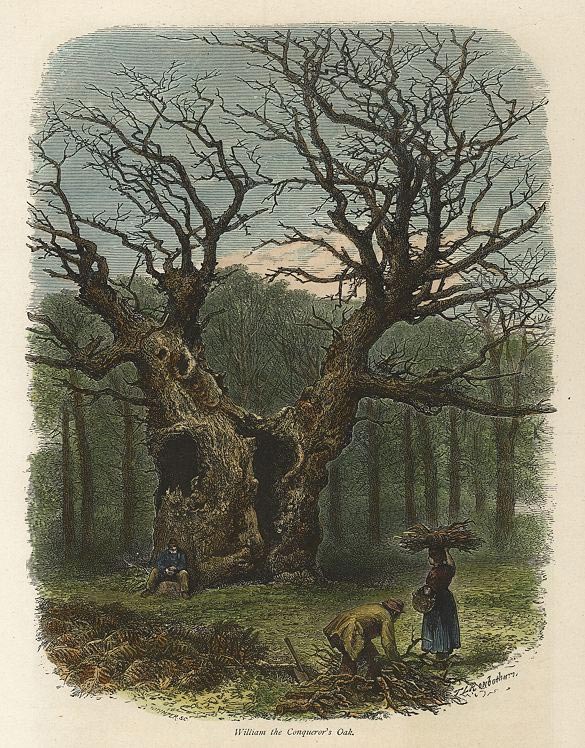I threw a picnic in our garden the other day. We were busy with all…
Windsor Great Park’s famous oak trees
Windsor Forest used to be a huge oak forest but because of landscaping and timber used for building houses, many trees were felled. Yet, there are huge, ancient , solitary oaks standing in the Park, making it one of the biggest oak forests in Northern Europe.
Believe it or not, some of the oak trees have fascinating stories. In this post I am going to tell you the stories of Windsor Great Park’s famous oak trees.
1) Victoria Oak
The Victoria Oak in Windsor Forest had a long and thinish trunk which inspired the engineer John Smeaton to design Plymouth lighthouse. He observed how flexible and strong the Victoria Oak was and how it swayed in a storm.

Smeaton was commissioned to build a lighthouse on the Eddystone Rocks, near Plymouth, in 1756. It must had been a challenge as the previous two constructions perished: the first one collapsed and killed its designer, the second one burnt down. Although the light-housekeeper survived the fire, he claimed to have swallowed 8 ounces of molten lead. Nobody believed him, but 6 days after the fire he died and the lead was found in his stomach during the autopsy.
First, Smeaton built a base using rocks that looked like a hollow tree, allowing the lighthouse to sway in the wind just like the Victoria Oak did in Windsor Forest. Well, the Victoria Oak did not survive, but Smeaton’s Lighthouse did! It is to be found, after it was disassembled and rebuilt, on the shore at Plymouth harbour.
2) The Conqueror’s Oak
The Conqueror’s Oak is also known as the King’s Oak and has been around since William the Conqueror. During the centuries it was used as a hanging tree as well. The Canadians who were stationed here during the First World War claim to have felled the oak, but its trunk is still standing on the very spot where old maps show it.

3) Offa’s Oak
Close to the Conqueror’s Oak is perhaps Windsor Great Park’s oldest oak to be found: Offa’s Oak. Its trunk split into two a long time ago, but the tree is still alive and sprouting leaves. According to experts Offa’s Oak can be as old as 1500 years. Offa was a Saxon king in the 8th century.
4) Herne the Hunter
The most famous figure of Windsor Great Park is Herne the Hunter, who is said to haunt the park with antlers on his head riding a horse. What does he have to do with antlers?

According to the legend, Herne was King Richard II’s favourite hunter and thus subject of hate by the rest of the royal hunters. One occasion Herne saved the king’s life in a wild boar attack, but he had life threatening injuries himself. At this point a wizard called Urswick appeared and said to the king he could save Herne‘s life. The King begged Urswick to do so. Urswick put a head of a stag on Herne’s head, then took him to his own Cottage in the forest to cure him there. The jealous hunters followed Urswick and threatened him and asked him to kill Herne. Urswick said, he had given his word to the king he would save Herne’s life, therefore he could not kill him. But he promised the royal hunters that Herne will lose his talent.
Once Herne recovered he did go out to hunt with the King. However, his performance was so bad, that the king sent him away. Herne being frustrated, depressed and despaired went to Windsor Forest where he hung himself. He was found later by somebody who went to town and asked for help. By the time they got back to the tree, the Herne’s body was not there anymore. Allegedly Herne took revenge and persuaded the king to hang the jealous hunters on the tree where Herne committed suicide. Since then, Herne’s ghost is often seen in Windsor Great Park in the form of a rider wearing antlers.
Also, the story was referenced by Shakespeare in “The Merry Wives of Windsor”.
Sometime a keeper here in Windsor Forest,
Doth all the winter-time, at still midnight,
Walk round about an oak, with great ragg’d horns;
And there he blasts the tree, and takes the cattle,
And makes milch-kine yield blood, and shakes a chain
In a most hideous and dreadful manner.
You have heard of such a spirit, and well you know
The superstitious idle-headed eld
Receiv’d, and did deliver to our age,
This tale of Herne the Hunter for a truth.
— William Shakespeare, The Merry Wives of Windsor
~




Great descriptions, thank you. I am Canadian and I was told that in 1936 (?) Britain sent a lot of oak saplings to Canada and they were called “Coronation Oaks.” They were from a famous oak tree in Windsor Park, I thought it was Herne’s Oak, but I may be mistaken. Do you know?
Thank you, Sharon, I am pleased you liked the post. That’s right, acorns shed from Windsor Great Park were sent to the Commonwealth and planted. I am not hundred percent sure, but I do not think Herne’s Oak exists (certainly not the original one). There was a debate anyway about its whereabouts. One of them was felled, the other one was blown down. As far as I know, a new tree was planted at the beginning of the 20th century which then was given the title Herne’s Oak. If the acorns were from this particular tree, then yes, the Coronation Oaks are from Herne’s Oak – but not the “original” one, the one from Shakespeare’s time. Hope this makes sence? Again, thank you for your comment and feedback! Gizella
Hey, we live close to Windsor Great Park (in Englefield Green) and would love to know if I can find out exactly where some of these great oaks are located; we know the park well but would love to be able to pin point them if possible. Any guidance of where I can find this out would be great. Thank you
Hi Sarah, Apologies for the delayed answer. Unfortunately, I don’t know the exact location of these oak trees. That requires another research. I’m planning to do more research about Windsor and Windsor Great Park very shortly. I’ll come back to you if I find something, just bear with me. (Unless, of course you’ve found them since. 🙂 ) Thank you.